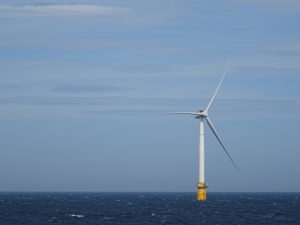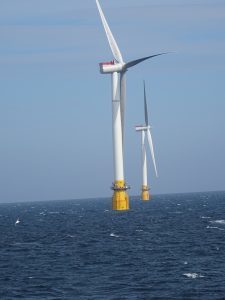A pioneering new North Sea renewables project will be supplying power to the north-east of Scotland in a matter of weeks.
Statoil’s Hywind project is the world’s first ‘floating’ wind farm.
And the 30 megawatts generated by the five turbines at the site, 15 miles off Peterhead, will soon be supplying electricity directly to the equivalent of 20,000 homes.
The turbines are expected to generate first power in October, with the resultant energy going down an export cable straight into Peterhead.
It means in around six weeks, all going well, green energy will be powering kettles, tumble dryers TVs and more around the Blue Toon.
The Hywind Pilot Project, as it is known, is built to test multiple units on a bigger scale than previous attempts.
If successful it could be rolled out worldwide as a new way to harness wind power in harsh deepwaters.
Halvor Hoen Hersleth, operations manager for the project, said: “Hywind is based on conventional technology used in a new way based on our oil and gas background.
“The most important concept about Hywind is the motion controller, which has been developed by Statoil since 2001.
“The Hywind Scotland project is meant to take things one step further. We are going bigger, with more turbines and we are also testing the market.
“There were a lot of challenges involving construction. We learned a lot of important lessons overcoming these challenges on this project.
“The last part is to verify this technology and make it even better for future projects.”
He added: “We have an offshore export cable which goes from the field into Peterhead. It is connected first to a small Statoil substation then a direct feed into the Peterhead distribution grid.
“So people in Peterhead will actually be lighting their lights with electricity from Hywind Scotland.
“We have concluded engineering and fabrication and at the moment we have just anchored the fifth and final turbine.
“In the operational phase we swill strive to demonstrate cost reduction. We also want to verify this concept and show this works and prepare for the deployment of more turbines around the world.”
The wind turbines are nearly twice the size of Big Ben with blades the same width as a passenger plan’s wing span.
They are held in place above the seabed with three mooring lines connected to ‘suction anchors’. A motion compensation system, develpoed by Norway’s Statoil, keeps the turbines steady, despite the stormy surroundings.
The design, allows them to be deployed in waters up to 700 metres deep according to Statoil – more than three times the depth at which current ‘fixed’ foundation turbines can be placed.
This gives greater access to high winds in offshore environments.
The £200million project, co financed by Abu Dhabi’s Masdar, has created 10 jobs in Peterhead, with staff in Aberdeen and Great Yarmouth providing support.
Hedda Felin, managing director at Statoil Production UK said: “This is a great pleasure and a big milestone for us to see all five turbines at the same time and welcome Hywind to Scotland.
“Hywind Scotland is something special, most of all because it is the world’s first floating wind farm.
“Oil and gas is our core business and that will remain but we are proud to say that we are an energy company now and we are more and more interested in new energy solutions.
“We see that there is an energy transition happening and we can see that the energy mix will be different in the future. Renewables is one of the areas with the fastest growth and we want to be part of that.
“The UK has also been selected as the hub for offshore wind for Statoil. It’s close to Norway, there are good winds and good bedrock.
“The UK is one of our largest and most important parts of our international portfolio. The Norwegian continental shelf will continue to be our backbone… but the growth will be internationally.
Recommended for you


